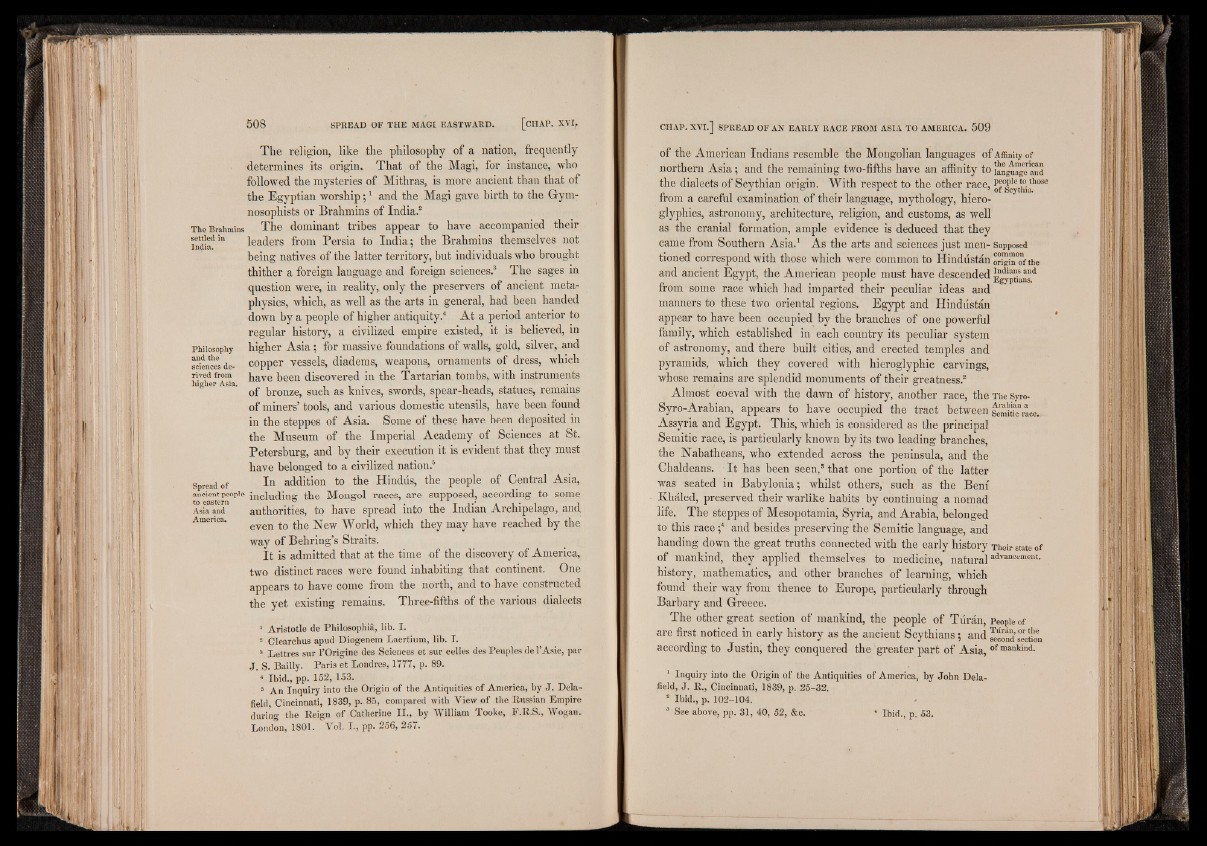
The religion, like the philosophy of a nation, frequently
determines its origin. That of the Magi, for instance, who
followed the mysteries of Mithras, is more ancient than that of
the Egyptian worship; 1 and the Magi gave birth to the Gym-
nosophists or Brahmins of India.8
The Brahmins The dominant tribes appear to have accompanied their
se ttledm leaders from Persia to India; the Brahmins themselves not India. _ 5 . . . , , i l i_ being natives of the latter territory, but individuals who brought
thither a foreign language and foreign sciences.3 The sages in
question were, in reality, only the preservers of ancient metaphysics,
which, as well as the arts in general, had been handed
down by a people of higher antiquity.4 At a period anterior to
regular history, a civilized empire existed, it is believed, in
Philosophy higher Asia; for massive foundations of walls, gold, silver, and
sciences de- copper vessels, diadems, weapons, ornaments of dress, which
rived from p a v e been discovered in the Tartarian tombs, with instruments
higher Asia. , . . of bronze, such as knives, swords, spear-heads, statues, remains
of miners’ tools, and various domestic utensils, have been found
in the steppes of Asia. Some of these have been deposited in
the Museum of the Imperial Academy of Sciences at St,
Petersburg, and by their execution it is evident that they must
have belonged to a civilized nation.4
Spread Of In addition to the Hindus, the people of Central Asia,
ancient people including the Mongol races, are supposed, according to some
Asia and authorities, to have spread into the Indian Archipelago, and
America. to AJ World, which they may have reached by the
way of Behring’s Straits.
It is admitted that at the time of the discovery of America,
two distinct races were found inhabiting that continent. One
appears to have come from the north, and to have constructed
the yet existing remains. Three-fifths of the various dialects
' Aristotle de Philosophic, lib. I.
* Clearchus apud Diogenem Laertium, lib. I.
3 Lettres sur l’Origine des Sciences et sur celles de sPeu p lesd el’Asie, par
J . S. Bailly. Paris et Londres, 1777, p. 89.
* Ibid., pp. 152, 153.
5 An Inquiry into the Origin of the Antiquities of America, by J . Dela-
field Cincinnati, 1839, p. 85, compared with View of the Russian Empire
during the Reign of Catherine I I ., by William Tooke, F.R.S., Wogan.
London, 1801. Vol. I ., pp. 256, 257.
of the American Indians resemble the Mongolian languages of Affinity of
northern Asia; and the remaining two-fifths have an affinity to language and
the dialects of Scythian origin. With respect to the other race, sPcythiah0£e
from a careful examination of their language, mythology, hieroglyphics,
astronomy, architecture, religion, and customs, as well
as the cranial formation, ample evidence is deduced that they
came from Southern Asia.1 As the arts and sciences just men- Supposed
tioned correspond with those which were common to Hindustan origin°of the
and ancient Egypt, the American people must have descended g dlp“a“ d
from some race which had imparted their peculiar ideas and
manners to these two oriental regions. Egypt and Hindustan
appear to have been occupied by the branches of one powerful
family, which established in each country its peculiar system
of astronomy, and there built cities, and erected temples and
pyramids, which they covered with hieroglyphic carvings,
whose remains are splendid monuments of their greatness.2
Almost coeval with the dawn of history, another race, the The Syro-
Syro-Arabian, appears to have occupied the tract between Semitic"race.
Assyria and Egypt. This, which is considered as the principal
Semitic race, is particularly known by its two leading branches,
the Nabatheans, who extended across the peninsula, and the
Chaldeans. It has been seen,5 that one portion of the latter
was seated in Babylonia; whilst others, such as the Beni
Khaled, preserved their warlike habits by continuing a nomad
life. The steppes of Mesopotamia, Syria, and Arabia, belonged
to this race ;4 and besides preserving the Semitic language, and
handing down the great truths connected with the early history Their state of
of mankind, they applied themselves to medicine, naturaladvanoement-
history, mathematics, and other branches of learning, which
found their way from thence to Europe, particularly through
Barbary and Greece.
The other great section of mankind, the people of Turan, People of
are first noticed in early history as the ancient Scythians; and ^coldsition
according to Justin, they conquered the greater part of Asia, of mankind.
I Inquiry into the Origin of the Antiquities of America, by John Dela-
iieid, J . R., Cincinnati, 1839, p. 25-32.
8 Ibid., p. 102-104.
II See above, pp. 31, 40, 52, &c. 4 Ibid., p. 53.